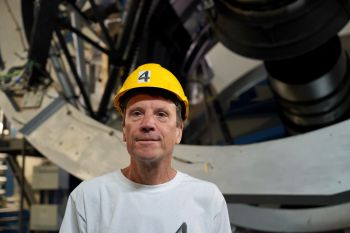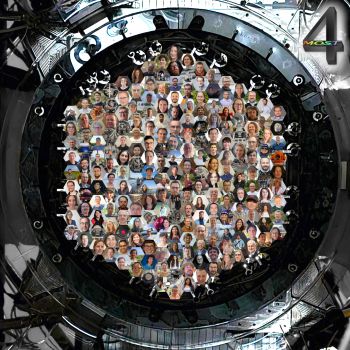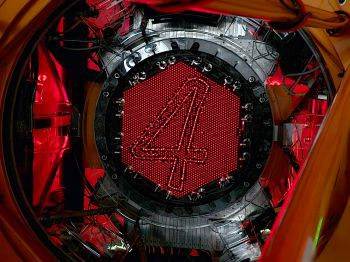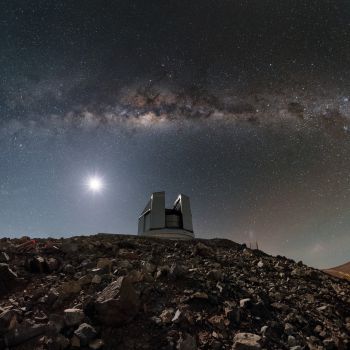Physics and Astronomy news
Read the latest news from the Physics and Astronomy department.
4MOST captures first light — University of Sussex contributes to Europe’s newest spectroscopic telescope
By: Kellie Powney
Last updated: Monday, 27 October 2025

Prof Jonathan Loveday, a faculty member of the University of Sussex and the 4MOST Extragalactic Project Scientist at the VISTA telescope. Credit: AIP/R. de Jong

People of 4MOST - An image of the 4MOST instrument, overlaid with hexagonal images illustrative of individual fibres. Each hexagon contains the face of a person involved in 4MOST, symbolising the people behind the project Credit: 4MOST/Moritz Gammel

The fibres of 4MOST are arranged in a "4". Each of the 2400 glass fibres can be moved to point at a celestial object. Credit: ESO/4MOST/Steffen Frey

Shown here is the Visible and Infrared Survey Telescope for Astronomy (VISTA), situated at the Paranal Observatory. Credit: ESO/B. Tafreshi (twanight.org)
The 4-metre Multi-Object Spectroscopic Telescope (4MOST), mounted on ESO’s VISTA telescope at Paranal, Chile, achieved first light on 18 October 2025, marking the transition from construction to on-sky validation.
The University of Sussex has contributed across commissioning, science verification, and survey science in several 4MOST extra-galactic surveys, including cosmology and galaxy-evolution surveys such as the Cosmology Redshift Survey (CRS), Wide-Area VISTA Extragalactic Survey WAVES and the Galaxy Clusters Survey. Our Sussex 4MOST team comprises four faculty members and five students. Among them, Professor Jon Loveday (4MOST Extragalactic Project Scientist) was part of the team capturing first light on sky, and three Sussex PhD students serve within the Commissioning and Science Verification teams.
About the first-light observations
The First Light observations exemplify the unique capabilities of 4MOST: its ability to observe a very large field of view and its capability to investigate a large number of very different objects and science cases simultaneously in great detail.
One of the objects dominating the First Light observation of 4MOST is the elongated galaxy NGC253, also called the Sculptor galaxy. Except for the Magellanic Clouds, it is the galaxy with the largest apparent diameter in the southern sky, with nearly the same diameter as the moon, only much fainter. It was discovered by Caroline Herschel in 1783 and is located at a distance of about 11.5 million light-years. It is currently known to be forming a large number of new stars. The 4MOST observations also capture a star cluster, various hot and cold stars and their movements, and gas glowing from newly formed stars in this galaxy.
The other large object seen in the field is the Globular Cluster NGC288, a very dense group of about 100,000 very old stars in the outskirts of the Milky Way. It formed about 13.5 billion years ago in the very earliest phases of the formation of the Milky Way. Its stars contain very small amounts of most chemical elements heavier than hydrogen and helium, reflecting its pristine composition.
You can watch the First Light video on YouTube: https://youtu.be/UyQ2t4gf-ao
Next to these two very large objects, 4MOST obtained spectra of more than two thousand other objects in its first science observation. These include spectra of a large variety of bright and faint stars in our Milky Way, allowing scientists to determine their temperature, mass, diameter, velocity, age and evolutionary stage, and chemical composition. Beyond the Milky Way, spectra of a pair of overlapping galaxies at 900 million light-years were obtained, as well as spectra of more than a thousand other galaxies near and far –up to 10 billion light-years! To determine their distance, internal velocity, and star formation history or the mass of their central black hole.
Users, Surveys, Science
The 4MOST science team consists of more than 700 investigators from universities and research institutes around the world. In its first five years of operations, 4MOST will conduct 25 different science programmes, ten designed by institute members of the consortium that built the instrument, whereas the other fifteen programmes were selected by the ESO user community. Uniquely, the multi-fibre nature of 4MOST enables many science programmes to be observed simultaneously. For example, a few fibres can be used to study rare objects, while at the same time another program can use most other fibres to make large statistical samples of stars or galaxies. Highlighted 4MOST science cases are the origin of the chemical elements and the formation of the first stars, the growth of the Milky Way over cosmic time, the formation and evolution of galaxies and black holes, the make-up of the unseen Dark Matter that seems to encompass most of the mass in galaxies, and the nature of Dark Energy that drives the accelerating expansion of the Universe.
About the facility
At the heart of the system, 4MOST uses 2436 optical fibres, each the size of a human hair, to catch the light of celestial objects. Light from each of these fibres is transported to the spectrographs that break up the light into its different colours. A large, new, nearly 1m-diameter optical camera lens system was installed in the VISTA telescope of the European Southern Observatory (ESO) in Chile to give 4MOST a field of view on the sky of 2.5 degrees in diameter, five times larger than the diameter of the moon and one of the largest in the world for a 4m-class telescope. 4MOST will observe a new set of objects in the sky every 10–20 minutes using a fibre positioner that moves all fibres to observe new objects in less than 2 minutes. The fibres transport the light to three spectrographs, each of which observes 812 objects simultaneously. Their light is first broken up into red, green, and blue components, and then, in further detail, registered by large 36-megapixel detectors. There are two spectrographs that cover the entire colour spectrum from the very blue all the way into the infrared (370–950 nm), whereas a third spectrograph looks at higher wavelength resolution in three selected colour bands to better measure chemical element abundances in stars.
Operations
Planning of 4MOST observations is done remotely from the Max Planck Institute for Extraterrestrial Physics (MPE) in Garching near Munich. A few minutes before the next observation needs to start, the next field and new objects are optimally selected based on the latest weather and observing conditions information. Executing the observations and maintaining the instrument is the responsibility of the European Southern Observatory (ESO). The data obtained are transferred to the 4MOST data centre at the University of Cambridge, where they are analysed with an extensive set of software pipelines to extract physical parameters of the studied objects. The analysis results are then transferred to data archives at the Leibniz Institute for Astrophysics Potsdam (AIP) and ESO to be distributed to all project members and to the entire scientific community for scientific exploration.
Consortium and Construction
The 4MOST facility is designed, built, and scientifically operated by a Consortium of 30 universities and research institutes in Europe and Australia under the leadership of the Leibniz Institute for Astrophysics Potsdam (AIP). The main institutes involved in building and operating the facility are:
- Leibniz Institute for Astrophysics Potsdam (AIP): consortium lead, telescope corrector and guiding system, metrology, control software, fibre system, and archive system,
- Macquarie University / Australian Astronomical Optics (AAO): fibre positioner,
- Centre de Recherche Astrophysique de Lyon (CRAL): low-resolution spectrographs,
- European Southern Observatory (ESO): detector systems
- Max Planck Institute for Astronomy (MPIA): instrument control hardware
- ·Max Planck Institute for Extraterrestrial Physics (MPE): observation planning and remote operations,
- ·Nederlandse Onderzoekschool Voor Astronomie (NOVA): calibration system,
- University of Cambridge, Institute of Astronomy (IoA): data management,
- Universität Hamburg (UHH), Hamburger Sternwarte: archive and user management,
- Universität Heidelberg, Zentrum für Astronomie (ZAH): high-resolution spectrograph and instrument control software.
All these institutes are also involved in the scientific analysis and exploration, as are the following major consortium partners: University of Sussex, Durham University, École polytechnique fédérale de Lausanne (EPFL), Lunds universitet, Rijksuniversiteit Groningen, University of Bath, University of Western Australia, Uppsala unversitet, and minor consortium participants: Georg-August-Universität Göttingen, L'Observatoire de Paris, Laboratoire des Matériaux Avancés, Max-Planck-Institut für Radioastronomie, University College London, Universität Potsdam, University of Tartu, University of Warwick, Lancaster University, University of Portsmouth, University of Southampton, and Queen’s University Belfast.
You can find 4MOST on social media:
- YouTube https://www.youtube.com/@4most-eu
- Bluesky @4most-eu.bsky.social
- Instagram @4most.eu
- LinkedIn https://www.linkedin.com/company/4most-eu
Also, to learn more about 4MOST, you can visit the 4MOST website at 4most.eu.